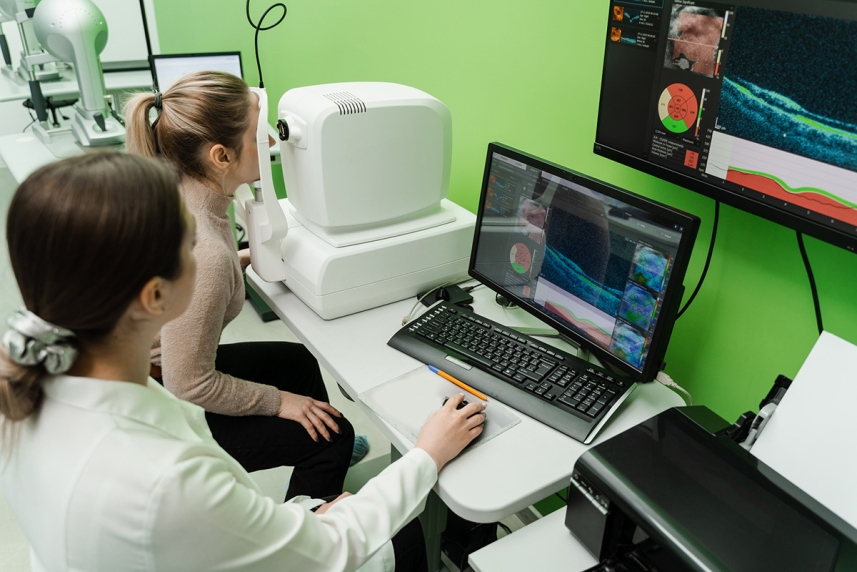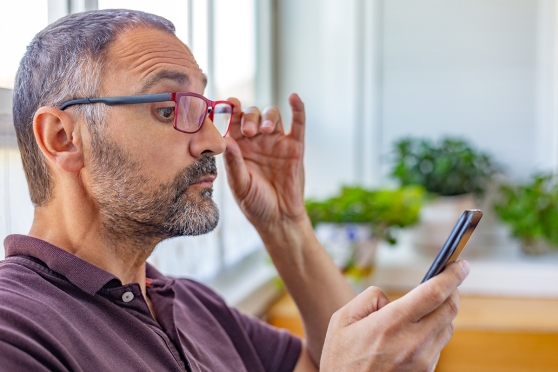How tech may help detect and treat age-related macular degeneration (AMD)
This serious vision-related issue may lead to vision loss in some older adults. Here’s how technology can help eye care providers.

If a person is 50 years old or older and getting regular eye exams, their eye care provider likely mentioned age-related macular degeneration (AMD). It’s a chronic eye disease that damages the macula, the part of the retina that controls central vision.1 (The retina is the light-sensitive layer of tissue at the back of the eye.)
Eye care providers are on the lookout for AMD in patients 50 or older, because it’s a leading cause of vision loss in people their age.1 (AMD comes in 1 of 2 forms: dry or wet.)
But many eye care providers are fighting the good fight. One of the tools they can use to identify and treat AMD is technology.
If a person is worried about AMD, here are 4 potential ways technology can help them get a faster diagnosis and better treatment.
Consult with an in-network eye care provider about common age-related health issues like AMD — and get the answers you may need. Search for a provider now.
1. Optical coherence tomography (OCT) scans2
OCT scans are a way of imaging that uses light waves to take detailed pictures of a person’s retina.2 They may help eye care providers diagnose and monitor AMD and other eye-related issues.
That can be done by mapping and measuring the thickness of the retina’s layers and the optic nerve fiber layer.2 (That’s a bundle of nerves that sends information from the eye to the brain.)
These scans may also help eye care providers treat other vision-related issues, such as:2
- Glaucoma, a chronic eye disease that may damage the optic nerve. It could lead to vision loss or blindness.3
- Macular edema, an eye condition in which fluid from damaged blood vessels can build up in the macula and cause it to swell. It could lead to vision loss or blindness.4
- Diabetic retinopathy, an issue that can damage the tiny blood vessels that go to the retina in people with diabetes.5
2. Artificial intelligence (AI)-assisted imaging and early detection tools
As noted above, AMD comes in 2 forms: dry or wet. The dry type may be the most common, affecting about 80% of people who have AMD. The wet type is less common and more serious.1 For most people, they can lose vision gradually over 5 years or more.6
Artificial intelligence (AI) and deep learning (DL) algorithms may help detect AMD early in some patients. (An algorithm is a set of instructions that may be followed to complete a task or solve a problem.)
These algorithms have demonstrated high accuracy in detecting AMD. That could include:7
- A pooled sensitivity of 94%. (That means, across multiple studies, these algorithms had a high probability of detecting AMD when the patient had the disease.)
- A pooled specificity of 97%. (That means that the algorithms don’t detect AMD when the patient doesn’t have the disease — so it’s rare to get a false positive.)
DL-based systems may be able to predict a patient’s risk of developing late-stage AMD. They may do that by combining imaging data with other patient data such as age, genetic profile and smoking status. This technology may also help with early detection and better personalizing patients’ treatment plans.6,7
3. Anti-VEGF shots for wet AMD8
For patients with wet AMD, anti-VEGF shots may be a helpful treatment. They can improve vision in about 1 in 3 people who take it. (VEGF stands for vascular endothelial growth factor, which is a type of protein the body produces.)
These drugs block a protein that promotes the growth of abnormal blood vessels. The growth can lead to low vision or blindness. But by blocking the protein, these shots may improve a person’s vision.
Newer treatments may even offer the potential for longer-lasting effects. They can reduce the frequency of shots needed.9
4. Gene therapy
Gene therapy is emerging as an approach for treatment of wet AMD.9 That’s a treatment that may change a person’s genes to treat or prevent a disease.
Gene therapy could allow the eye to produce its own anti-VEGF medicine for people with wet AMD.
Another line of defense in the fight against AMD? Seeing an eye care provider regularly. Find an in-network provider in the UnitedHealthcare Vision Network today.
Sources:
- Understanding Macular Degeneration American Academy of Ophthalmology, October 2024.
- What Is Optical Coherence Tomography? American Academy of Ophthalmology, September 2024.
- Glaucoma National Eye Institute, last updated December 2024.
- What Is Macular Edema? American Academy of Ophthalmology, September 2024.
- Diabetic Retinopathy National Eye Institute, last updated December 2024.
- AI-Based Systems Can Help Identify Rapidly Advancing Age-Related Macular Degeneration National Eye Institute, March 2023.
- Deep Learning for Detection of Age-Related Macular Degeneration: A Systematic Review and Meta-analysis of Diagnostic Test Accuracy Studies PLOS One, April 2023.
- Anti-VEGF Treatments American Academy of Ophthalmology, July 2023.
- New Treatments for Age-Related Macular Degeneration American Academy of Ophthalmology, March 2023.


